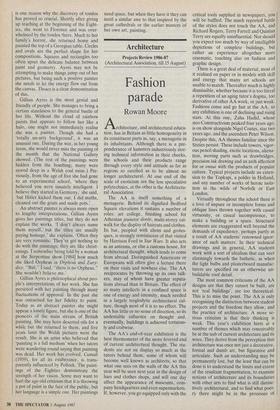Exhibitions
Gillian Ayres (Knoedler Gallery, till 5 September)
The joy of paint
Alistair Hicks
Don't listen to her, she'll make you paint!' fellow teachers warned their stu- dents against Gillian Ayres at St Martin's foundation course in the early Seventies. Even when it was unfashionable, Ayres enjoyed using paint. She is the most direct British link to Jackson Pollock. Knoedler's with its limited space cannot possibly do Gillian Ayres justice, but the exhibition gives a flavour as addictive as a Mediterra- nean climate. One passes from one paint- ing to the next with the same certainty that one wakes to a blue sky in the Bay of Naples.
Ayres' work is not easy to write about; it is very easy to look at. The bold colours, the fluid and joyous application of paint, demand respect. She is a highly modest person and rarely makes claims for herself. She prefers to refer obliquely to people and events that have not necessarily influ- enced her but with which she has sym-
pathy. She talks of Roger Hilton as 'the first man I met who talked about painting in a way I liked'. There is an affinity with Howard Hodgkin, who equally confronted the problems Abstract Expressionism left behind. Comparisons to Pollock induce the fear that 'it might not be fair to Pollock', but she does admit to adopting, like him, in the Fifties and Sixties, 'an arena in which to act when painting on the floor'. She no longer does so.
Gillian Ayres sets herself the highest ambitions. 'I'd like my paintings to have the same effect as Chartres or a late Titian,' she says, amidst a flurry of self- depreciation. Her best work does have similar abstract qualities, a freedom of expression that results from the tightest discipline. Her paintings are full of tem- pered explosions. There are pockets of containment. The Sorcerer's Apprentice (1986-87), for instance, is littered with compartments like those of an anatomical dummy. The natural expressive power of the paint is restricted. Her most successful compositions, like A Belt of Straw and Ivy Buds (1983), overcome this to burst like Catherine-wheels off the edge of the can- vas. 'Roger Hilton talked of the experience of things flying out of the canvas and joining up with people in the room,' she recalls.
Two of the paintings in the show are roughly 112 inches square, which Ayres admits is her favoured size, perhaps merely because of her physical reach. Sometimes her work is carried away by the size, which
is one reason why the discovery of tondos has proved so crucial. Shortly after giving up teaching at the beginning of the Eight- ies, she went to Florence and was over- whelmed by the tondos there. Much to her family's horror, she returned home and painted the top of a Georgian table. Circles and ovals are the perfect shape for her compositions. Squares and rectangles too often upset the delicate balance between paint and geometry. Ayres may not be attempting to make things jump out of her pictures, but being such a positive painter she needs to let the energy flow out from the canvas. Thrace is a clear demonstration of this.
Gillian Ayres is the most genial and friendly of people. She manages to bring a certain stateliness to the general bustle of her life. Without the cloud of rainbow paints that appears to follow her like a halo, one might not immediately realise she was a painter. Though she had a `totally un-arty background', it was an unusual one. During the war, in her young teens, she would never miss the painting of the month that the National Gallery showed. (The rest of the paintings were hidden from the bombing; many were stored deep in a Welsh coal mine.) Pre- viously, from the age of five she had gone to an experimental school, 'where they believed you were innately intelligent. I believe they started in Germany,' she said, `but Hitler kicked them out. I did maths, cleaned out the goats and made pots.'
An abstract painter is always more open to lengthy interpretations. Gillian Ayres gives her paintings titles, but they do not explain the works. 'I don't always name them myself, but the titles are usually paying homage,' she explains. 'Often they are very romantic. They've got nothing to do with the paintings; they are like christ- enings. I remember being told by a woman at the Serpentine show [1984] how much she liked Orpheus in Orpheus and Eury- dice. "But," I said, "there is no Orpheus." She wouldn't believe me.'
Gillian Ayres is philosophical about peo- ple's interpretations of her work. She has persisted with her painting through many fluctuations of approval. In the past she was ostracised for her fidelity to paint. Today as an abstract painter she might appear a lonely figure, but she is one of the pioneers of the main stream of British painting. She may have deserted oils for a while but she returned to them, and five years later the Welsh pictures were the result. She is an artist who believed that `painting is a full medium' when her tutors were wandering round saying that painting was dead. Her work has evolved. Cumuli (1959), for all its exuberance, is trans- parently influenced by Pollock. The paint- ings of the Eighties demonstrate the strength of her vision. Some may want to hurl the age-old criticism that it is throwing a pot of paint in the face of the public, but her language is a simple one. Her paintings
need space, but when they have it they can instil a similar awe to that inspired by the great cathedrals or the earlier masters of her own art, painting.



















































 Previous page
Previous page